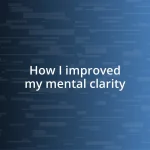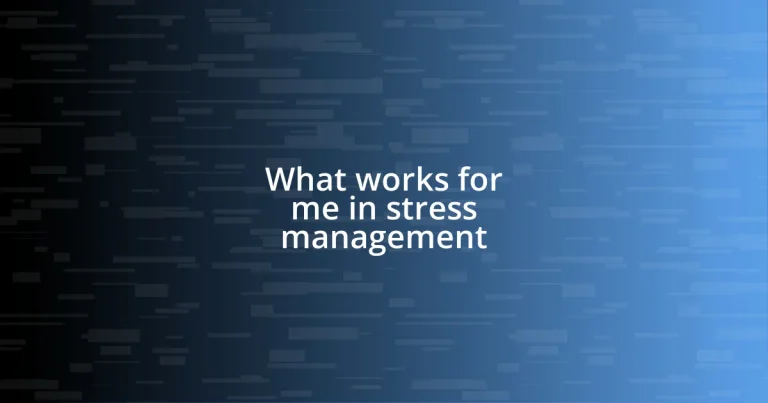Key takeaways:
- Finding the right stress management techniques is a personal journey, exemplified by the effectiveness of journaling and physical activity in alleviating stress.
- Self-awareness plays a crucial role in stress management, enabling individuals to identify triggers, regulate emotions, and cater to personal needs for better responses to stress.
- Regular evaluation of stress relief strategies is essential; adapting and adjusting methods helps maintain effectiveness and ensures a dynamic approach to managing stress.
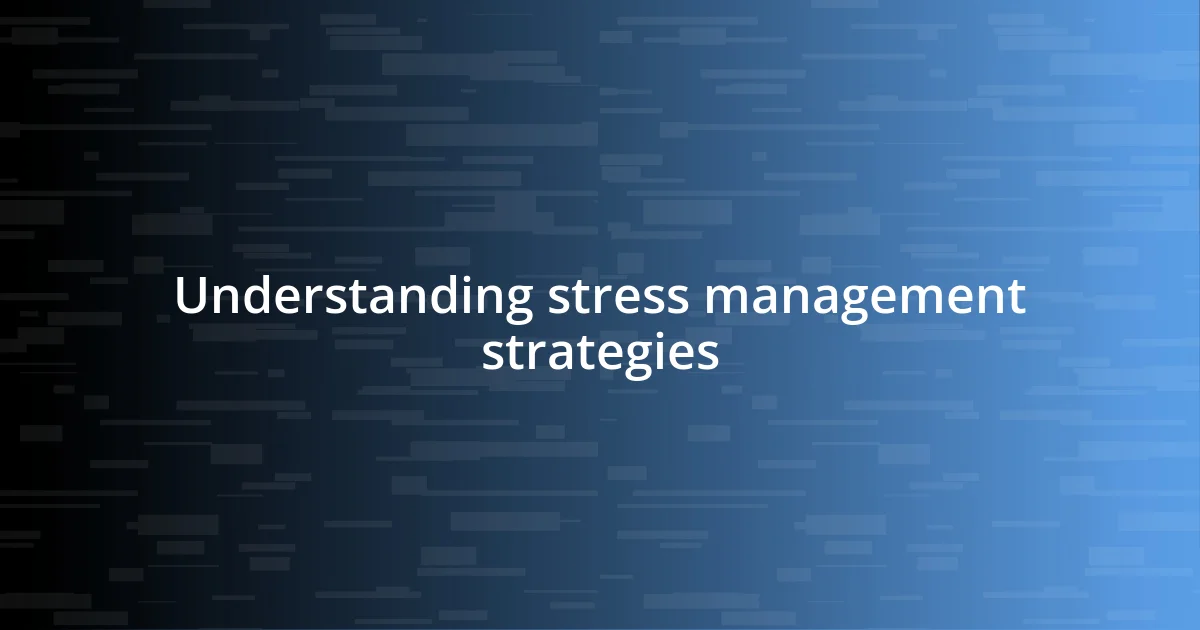
Understanding stress management strategies
When I first began exploring stress management strategies, I realized that not every method works for everyone. I found myself trying meditation, which left me feeling more anxious rather than relaxed. Have you ever felt the same way? It made me reflect on how important it is to find what resonates with you personally; it’s all about trial and error.
Over time, journaling became a cornerstone of my stress management toolkit. I remember those nights when my mind raced with worries, and just putting pen to paper helped me process my thoughts. Isn’t it fascinating how something as simple as writing can ground us? For many, this act not only clarifies emotions but also uncovers patterns in our stress triggers, providing valuable insights into how we can respond differently in the future.
I also discovered the value of physical activity in managing stress. I started going for short runs, and each time I hit the pavement, it felt like I was running away from my worries. Do you ever wonder how movement can shift our mindset so drastically? I find that those post-exercise endorphins not only lift my spirits but also foster a sense of accomplishment that helps combat stress in a vivid way.
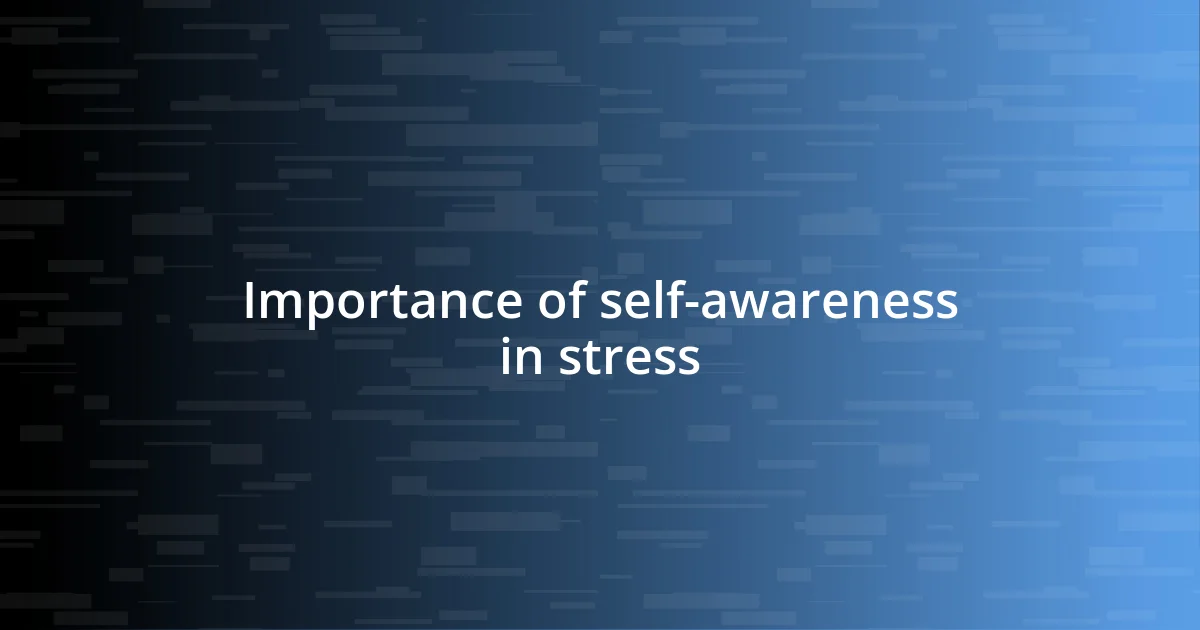
Importance of self-awareness in stress
Awareness of our emotional states plays a huge role in managing stress effectively. I remember a particularly overwhelming week when work deadlines loomed, and I felt a tightening in my chest. Taking a moment to pause and recognize that tightness helped me distinguish between stress, anxiety, and discomfort, allowing me to approach each feeling with greater clarity rather than reacting impulsively.
Self-awareness not only helps me identify stress triggers but also facilitates a deeper understanding of my responses to them. Just the other day, I noticed I was feeling irritable after a long day. Reflecting on that impulse allowed me to change the narrative of my day; instead of lashing out, I took a few minutes to breathe and regroup before interacting with others. This practice of recognizing my feelings leads to healthier interactions, impacting not just my stress but also those around me.
When we cultivate self-awareness, it opens up various pathways to manage stress more effectively. For instance, I make it a habit to check in with myself during challenging moments. This practice encourages me to ask, “What do I really need right now?” Whether it’s a moment of solitude, some fresh air, or even a healthy snack, tuning into my needs makes all the difference in how I respond to stress.
| Aspect | Impact of Self-Awareness |
|---|---|
| Identify Triggers | Understanding what causes stress helps in developing effective coping strategies. |
| Emotional Regulation | Being aware of our emotions enables us to respond intentionally rather than react impulsively. |
| Personal Needs | Acknowledging our needs allows for self-care practices that can alleviate stress. |
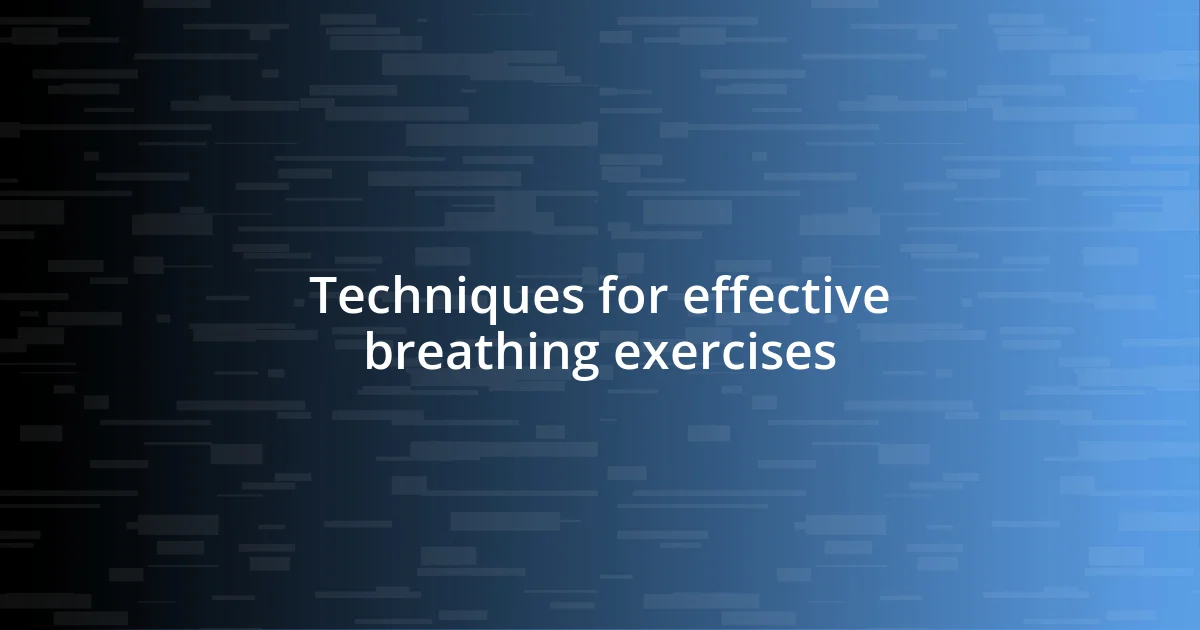
Techniques for effective breathing exercises
Breathing exercises have become a game-changer for me in managing stress. I vividly recall a moment when I felt overwhelmed before a big presentation. I stepped outside, took a minute to focus on my breath, and it felt like a weight lifted off my shoulders. Techniques like deep diaphragmatic breathing can be remarkably effective; they help shift our physiological state from stress to calm.
Here are some techniques I’ve found particularly helpful:
- Diaphragmatic Breathing: Breathe deeply through your nose, allowing your abdomen to rise, then exhale slowly. This engages your diaphragm and promotes relaxation.
- Box Breathing: Inhale for four counts, hold for four, exhale for four, and hold again for four. This structured pattern can help reset your mind.
- 4-7-8 Breathing: Inhale for four counts, hold your breath for seven, and exhale for eight. It’s surprisingly soothing and can help with sleep as well.
- Mindful Breathing: Focus solely on your breath—notice the sensations as you inhale and exhale. This encourages presence and reduces racing thoughts.
- Resonant Breathing: Breathe in for six counts and out for six. This technique has been linked to emotional regulation and overall well-being.
Experimenting with these techniques has added a sense of control during stressful moments. I now rely on them, especially when I feel the familiar tightness in my chest creeping in. Just the act of breathing mindfully can transform my perspective; it’s a small, powerful tool within reach, wherever I am.
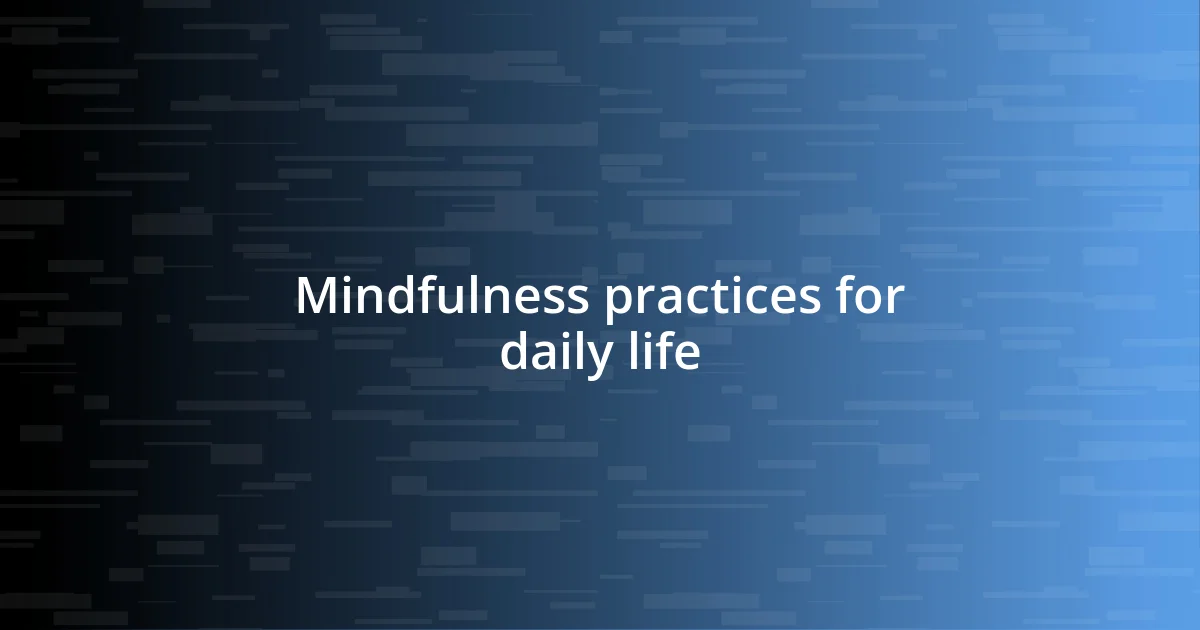
Mindfulness practices for daily life
Incorporating mindfulness practices into my daily routine has really transformed how I handle stress. For instance, I started to integrate short moments of mindfulness throughout my day, especially during lunch breaks. Instead of scrolling through my phone while eating, I focus on the flavors and textures of my food. This simple act grounds me, allowing me to reset my mind before diving back into my tasks. Have you ever tried just being present with your food? It can be surprisingly refreshing.
Another practice that I find particularly effective is mindful walking. Whenever I take a stroll, I consciously tune into my surroundings—the sounds of birds chirping or the feel of the wind against my skin. There was a time when I felt overwhelmed by decisions at work, and stepping outside for a brisk walk cleared my mind quite literally. The rhythm of my feet hitting the ground seemed to wash away the clutter, creating space for clarity and calm. It’s fascinating how something as routine as walking can shift our perspective when we pay attention.
I also utilize moments of mindfulness in real time during conversations. For example, when I feel a conversation becoming heated or stressful, I pause to take a breath before responding. I recently had a disagreement with a friend, and instead of reacting immediately, I held back and centered myself. This not only helped diffuse the tension but allowed me to communicate with empathy. It’s amazing how mindfulness can reshape our interactions, don’t you think? Balancing awareness and action can truly foster stronger connections with those around us.
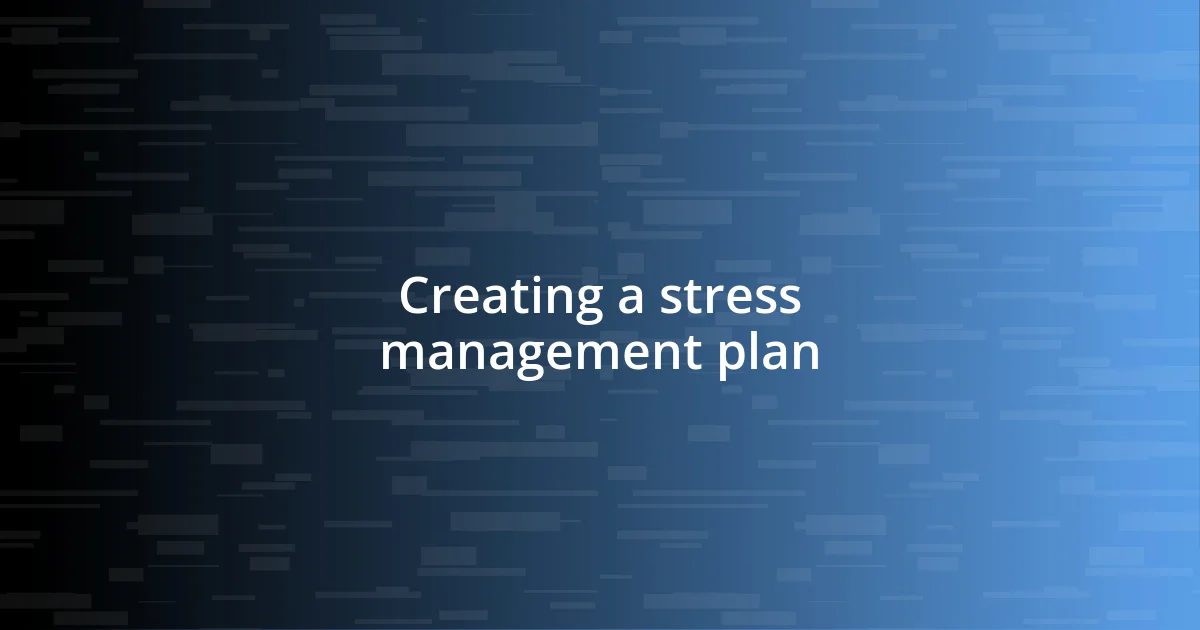
Creating a stress management plan
Creating a stress management plan has been a pivotal step in my journey toward well-being. I remember sitting down one weekend, feeling the weight of my responsibilities. I scribbled down my stress triggers and potential coping methods, realizing that having a plan gave me a sense of purpose. When stress hits, I now know I can pull from different techniques, whether it’s a breathing exercise or a quick mindfulness moment.
A key part of my stress management plan involves setting aside dedicated time for self-care activities. I often block off 30 minutes in my calendar just for myself—not just as a default, but as something I actively prioritize. Whether it’s diving into a good book or practicing yoga, this “me time” is a lifeline that recharges my energy. Have you ever thought about how taking scheduled breaks can help manage your overall stress? It has certainly changed my perspective on productivity.
Additionally, revisiting my plan regularly acts as a touchstone during chaotic weeks. I like to reflect on what worked well and what I might need to adjust. For instance, I once relied heavily on casual jogging to unwind, but I realized that some days, a soothing bath or simply listening to music serves my needs better. This dynamic approach helps me stay flexible. What are your go-to activities for stress relief? Exploring different options ensures that my toolbox stays full, ready for whatever life throws my way.
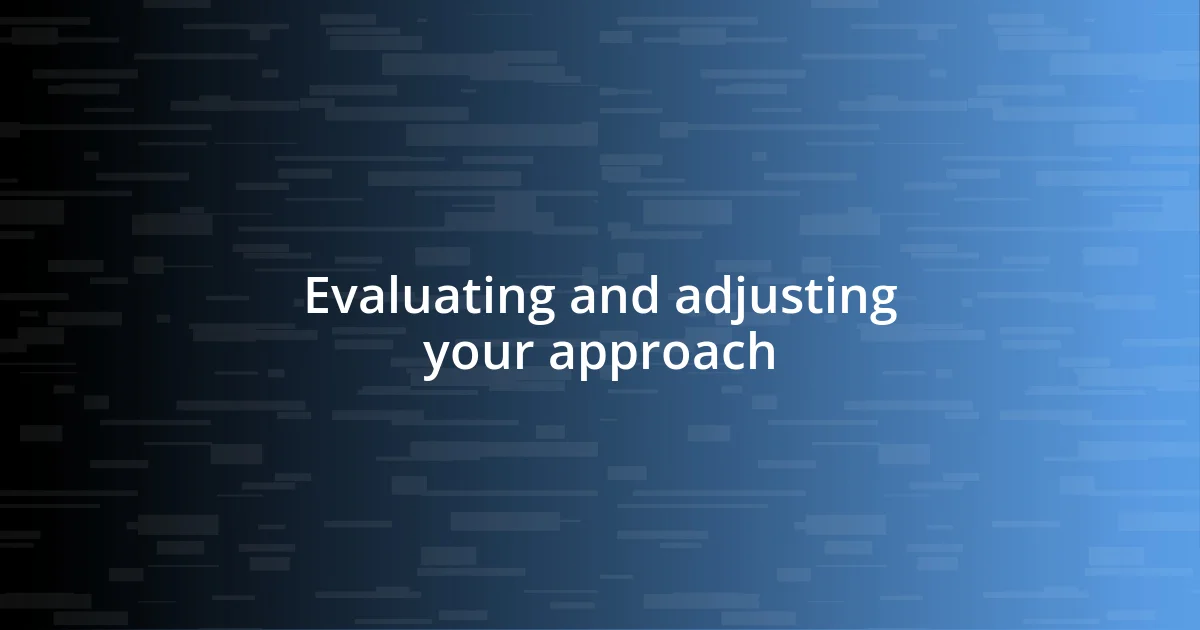
Evaluating and adjusting your approach
Evaluating the effectiveness of my stress management strategies has been an eye-opening experience. I remember a particularly stressful week at work when my usual methods felt insufficient, leaving me exhausted. I decided to take a step back and assess what wasn’t working for me. Asking myself, “Why didn’t that help in this instance?” led me to discover that my usual coping mechanisms needed a refresh. It’s crucial to recognize when something no longer fits your needs.
Adjusting my approach became a more intentional process. After reflecting on my stress triggers, I noticed that I often dismissed signs of fatigue. There was one instance where I pushed through the day despite feeling drained, only to end up irritable and unfocused. Now, I’ve learned to be more responsive to those signals. I’ve started incorporating moments of rest into my day, even if it’s as simple as a few deep breaths. How do you respond to your own stress signals? Listening to ourselves can significantly change our overall well-being.
It’s often surprising how I can discover new techniques that resonate with me when I regularly evaluate my practices. For example, I recently experimented with journaling. At first, I didn’t think it would be helpful, yet it became a powerful tool for processing my emotions. I recall a day filled with overwhelming tasks—writing freely for just ten minutes released pent-up thoughts and opened a path to clarity. Have you ventured into new territory with your stress management strategies? Embracing change might just lead you to your next favorite tool.








